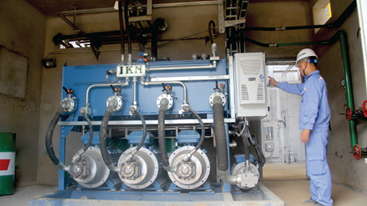The Government's view of the National Strategy on Green Growth clearly states that green growth contributes to the restructuring of the economy, associated with the renewal of the growth model, improving competitiveness and resilience to external shocks, realize the Socio-Economic Development Strategy 2021-2030, the national planning system, sector and field development strategies.
 The strategy sets a target that by 2050, the proportion of renewable energy in the total primary energy supply will reach 25-30%
The strategy sets a target that by 2050, the proportion of renewable energy in the total primary energy supply will reach 25-30%Green Growth is also an important measure to realize sustainable development, actively contribute to greenhouse gas emissions, towards a carbon-neutral economy in the long term. In particular, Greenhouses are people-centred, helping to reduce people's vulnerability to climate change, promoting responsible lifestyles of each individual towards the community and society, and orienting the next generation of green living culture.
Accordingly, in order to achieve the overall goal of contributing to the economic restructuring associated with renovating the growth model, achieving economic prosperity, environmental sustainability and social justice; towards a green, carbon-neutral economy and contributing to the goal of limiting global temperature rise, the Green Growth Strategy sets specific targets to reduce the intensity of greenhouse gas emissions per GDP; greening economic sectors; greening lifestyles and promoting sustainable consumption; greening the transition on the principles of equality, inclusion and resilience.
In which, with the goal of reducing the intensity of greenhouse gas emissions per GDP, the Strategy sets a target that by 2030, the intensity of greenhouse gas emissions per GDP will decrease by at least 15% compared to which of 2014; The goal is that by 2050, the intensity of greenhouse gas emissions as a percentage of GDP will be reduced by at least 30% compared to which of 2014.
In order to "green" the economic sectors, the Strategy aims to transform the growth model towards greening economic sectors, applying the circular economy model through exploitation and economical and efficient use of natural resources, based on science and technology, applying digital technology and digital transformation, developing sustainable infrastructure to improve growth quality, promote competitive advantages and reduce negative impact on the environment. Accordingly, the main goal by 2030 is to reduce primary energy consumption per GDP in the 2021-2030 period from 1.0-1.5%/year; the ratio of renewable energy to total primary energy supply reaches 15-20%; digital economy reaches 30% of GDP; forest cover rate is stable at 42%; at least 30% of the total irrigated dry crop area shall apply advanced and water-saving irrigation methods.
The main objective by 2050 is to reduce primary energy consumption per average GDP per period (10 years) by 1.0%/year; the proportion of renewable energy in total primary energy supply reaches 25-30%; strive for the digital economy to reach 50% of GDP; forest cover rate is stable at 42-43%; at least 60% of the total irrigated dry crop area shall apply advanced and water-saving irrigation methods.
In order to green lifestyles and promote sustainable consumption, the Strategy sets out the main goal that by 2030, the proportion of municipal solid waste collected and treated met the prescribed standards and regulations reaches 95%; the proportion of urban daily-life solid waste treated by the direct burial method compared to the collected waste is 10%; the rate of urban wastewater collected and treated up to standards and regulations as prescribed is over 50%, respectively, for urban centers of grade II or higher and 20% for the remaining urban types...
The goal is that by 2050, the rate of solid waste collected and treated meeting national standards and regulations will reach 100%, of which the burying of organic solid waste and recyclable waste should be minimized. ; 100% of urban areas are built synchronously and completed with water drainage systems, eliminating flooding in urban areas, and 100% of treated wastewater must meet technical regulations before being discharged to the waste sources.
In order to achieve the above objectives, the Strategy sets out orientations for the development of major sectors and fields in the direction of improving energy efficiency, reducing energy consumption in production, transportation, and operations, transport, trade and industry, ensuring national energy security in the direction of synchronous energy sources, exploiting and economically using domestic energy sources, and transforming the structure of energy sources in the direction of reducing energy consumption and less depend on fossil energy, promote efficient exploitation and increase the proportion of renewable and new energy sources in national energy production and consumption.
Along with that, develop modern agriculture, clean and sustainable organic agriculture, improve the quality, added value and competitiveness of agricultural production through adjustment and restructuring, livestock, crops, forestry, aquaculture and application of technological processes that use economically and efficiently seeds, feed, agricultural materials, natural resources... Along with that, promoting consumption use and green and sustainable purchasing through programs of energy labeling, eco-labels, green labels;
Promote green public procurement and continue to effectively apply economic tools to regulate consumption behavior. Step by step create the environment and form a green culture and lifestyle.
In order to achieve the goals set out in the Green Growth Strategy, the Government also assigns specific tasks to each ministry and sector, in order to focus on perfecting institutions and policies; communication and education to raise awareness; develop human resources and green jobs, mobilize financial resources; encourage scientific research, technology and innovation for Green Growth. In particular, establish a National Steering Committee on Green Growth to direct and implement the Strategy.
Ha Tran









.jpg?w=367&h=206&mode=crop) Notice for Contracts award for Support to Industrial Enterprises for Energy Audits and Preparation of Feasibility Studies (Package No. C2.2.4)
04/06/2024
Notice for Contracts award for Support to Industrial Enterprises for Energy Audits and Preparation of Feasibility Studies (Package No. C2.2.4)
04/06/2024
 Training Courses for Energy Managers and Energy Auditors
Training Courses for Energy Managers and Energy Auditors
 Vietnam Energy Outlook Report – Pathway to Net Zero
Vietnam Energy Outlook Report – Pathway to Net Zero
 Long Son Cement saves 30% of electricity consumption thanks to heat recovery
Long Son Cement saves 30% of electricity consumption thanks to heat recovery
 Expression of Interest: C2.1.15: Development of Energy-Efficient Technology Catalogs for the Industrial Sector
Expression of Interest: C2.1.15: Development of Energy-Efficient Technology Catalogs for the Industrial Sector
 Optimizing Compressed Air Systems for Southern Industrial Enterprises
Optimizing Compressed Air Systems for Southern Industrial Enterprises
 The Ministry of Industry and Trade Review the Energy Efficiency and Conservation activities in Lao Cai.
The Ministry of Industry and Trade Review the Energy Efficiency and Conservation activities in Lao Cai.
 EOI Extension: C2.2.2: Review and update for current EE benchmarking for 2 sub-industrial sectors
EOI Extension: C2.2.2: Review and update for current EE benchmarking for 2 sub-industrial sectors